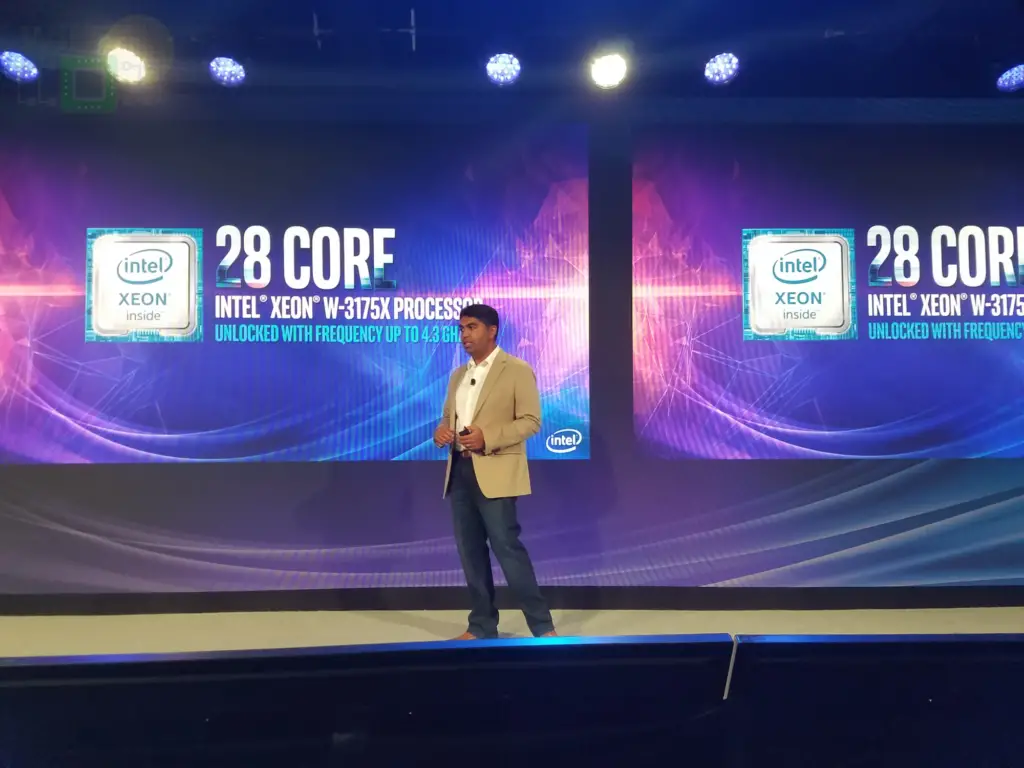Intel Discloses 9th Gen Core, Refreshes Core X, And Reintroduces STIM
Core X Refresh

Last year Intel introduced a series of high-end desktop processors based on the Skylake server microarchitecture (codename Skylake X). On Monday, Intel announced a refresh of their entire Core X lineup. There are seven new processors which will be available in November.
| Skylake X Refresh | ||||||||
|---|---|---|---|---|---|---|---|---|
| Model | Price (Tray) |
C/T | Base | Turbo | TDP | L3$ | ||
| TBT 2.0 | TBMT | |||||||
| i9-9980XE | $1,979 | 18/36 | 3.0 GHz | 4.4 GHz | 4.5 GHz | 165 W | 24.75 MiB | |
| i9-9960X | $1,684 | 16/32 | 3.1 GHz | 4.4 GHz | 4.5 GHz | 165 W | 22 MiB | |
| i9-9940X | $1,387 | 14/28 | 3.3 GHz | 4.4 GHz | 4.5 GHz | 165 W | 19.25 MiB | |
| i9-9920X | $1,189 | 12/24 | 3.5 GHz | 4.4 GHz | 4.5 GHz | 165 W | 19.25 MiB | |
| i9-9900X | $989 | 10/20 | 3.5 GHz | 4.4 GHz | 4.5 GHz | 165 W | 19.25 MiB | |
| i9-9820X | $889 | 10/20 | 3.3 GHz | 4.1 GHz | 4.2 GHz | 165 W | 16.5 MiB | |
| i7-9800X | $589 | 8/16 | 3.8 GHz | 4.4 GHz | 4.5 GHz | 165 W | 16.5 MiB | |
Note that the prices listed above are for tray as we currently don’t have box prices. The box prices will likely be around fifteen to twenty dollars higher. For example, the Core i9-7980XE has a tray price of $1,979, identical to the i9-9980XE, and a box price of $1,999.
There are a number of important changes to the new lineup. The first major observation is that Intel has dropped the low core count (LCC) die which had up to 10 cores. All the new parts appear to be based on the high core count (HCC) die which has up to 18 cores.
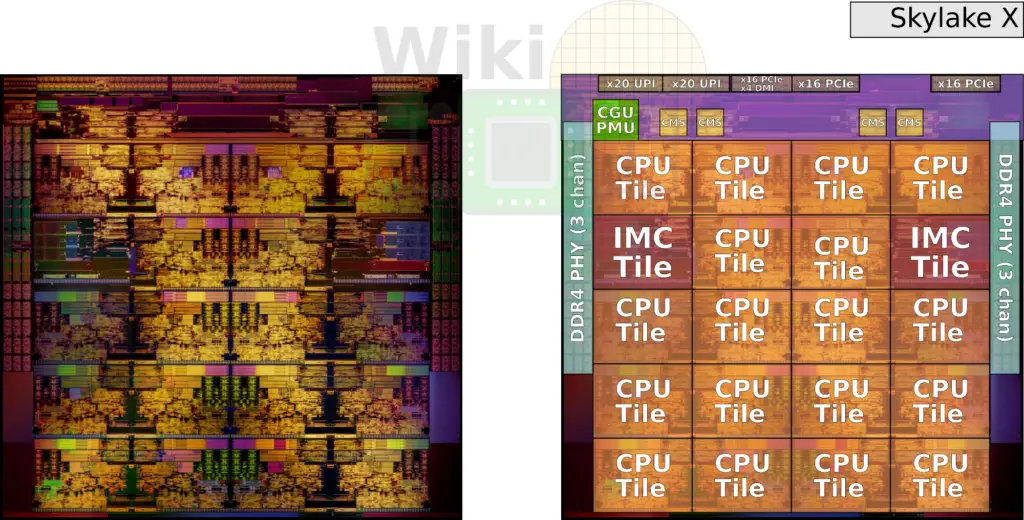
As a corollary of using the high core count die, a higher amount of cache is available for the low core count models.
| Core X L3 Cache Size | |||||||
|---|---|---|---|---|---|---|---|
| Skylake X | |||||||
| Model | Cores | Breakdown | L3 | ||||
| i7-7820X | 8 | 8 × 1.375 MiB | 11 MiB | ||||
| i9-7900X | 10 | 10 × 1.375 MiB | 13.75 MiB | ||||
| i9-7920X | 12 | 12 × 1.375 MiB | 16.5 MiB | ||||
| i9-7940X | 14 | 14 × 1.375 MiB | 19.25 MiB | ||||
| i9-7960X | 16 | 16 × 1.375 MiB | 22 MiB | ||||
| i9-7980XE | 18 | 18 × 1.375 MiB | 24.75 MiB | ||||
| Skylake X Refresh | |||||||
| Model | Cores | Breakdown | L3 | ||||
| i7-9800X | 8 | 12 × 1.375 MiB | 16.5 MiB | ||||
| i9-9820X | 10 | 12 × 1.375 MiB | 16.5 MiB | ||||
| i9-9900X | 10 | 14 × 1.375 MiB | 19.25 MiB | ||||
| i9-9920X | 12 | 14 × 1.375 MiB | 19.25 MiB | ||||
| i9-9940X | 14 | 14 × 1.375 MiB | 19.25 MiB | ||||
| i9-9960X | 16 | 16 × 1.375 MiB | 22 MiB | ||||
| i9-9980XE | 18 | 18 × 1.375 MiB | 24.75 MiB | ||||
The additional cache comes from tiles containing disabled cores. Those serve as larger buffers for evicted L2 lines but they are situated outside of the core tile on a separate mesh stop. The exact performance improvement needs to be carefully measured on workloads that would benefit from this.
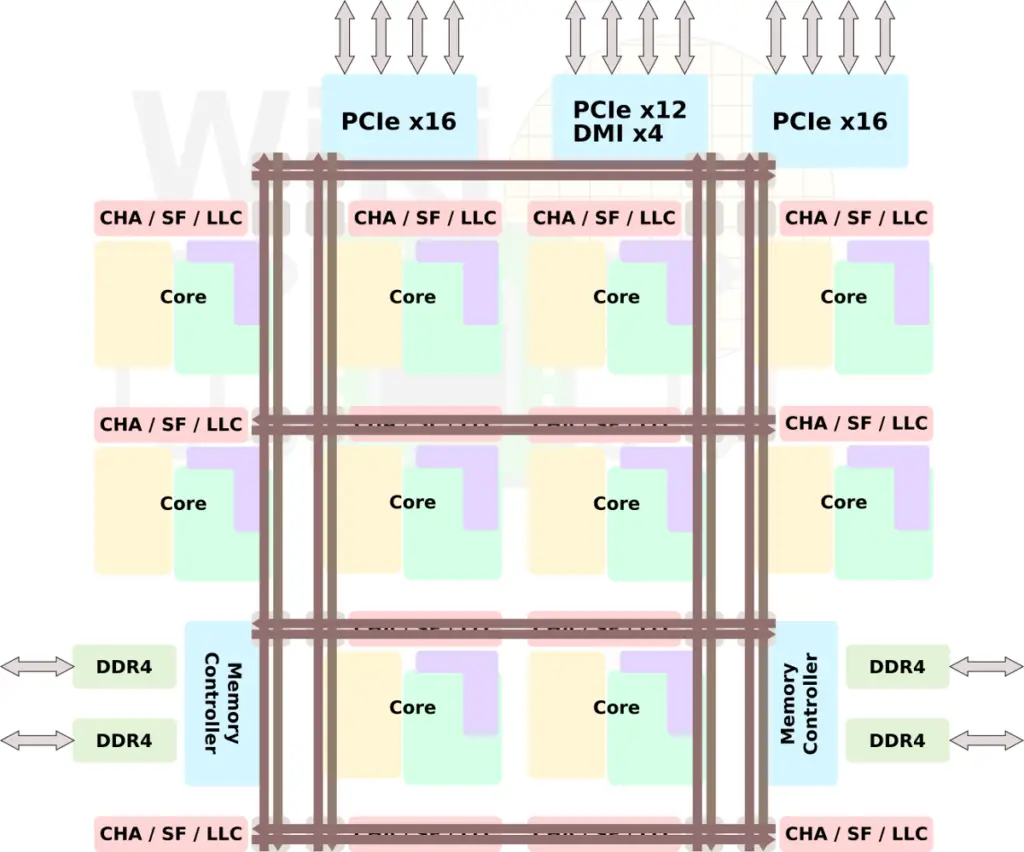
The new lineup got rid of the 6 core part and bumped the TDP to 165 W for all models. Additionally, Intel introduced a second deca-core processor at a lower price but slightly lower binned in terms of frequency. The i9-9820X is quite interesting because it’s $100 cheaper than the i9-9900X and only differs in price, frequency, and 2.75 MiB worth of L3. If it can be overclocked by just 2-3 bins to match the stock frequencies of the 9900X, it could be a more attractive deal for some people.
One of the more important changes is the PCIe lanes offered. Previously, the i7-7820X only had 28 PCIe lanes. For the new lineup, every processor has all 44 PCIe lanes available. Those sit on three independent converged mesh stops and are broken into three units of x16, x16, and x12 (the other x4 are for the DMI). Compared to last year processors, all the new models have either the same frequencies or higher (with the exception of the new lower price 10-core part).
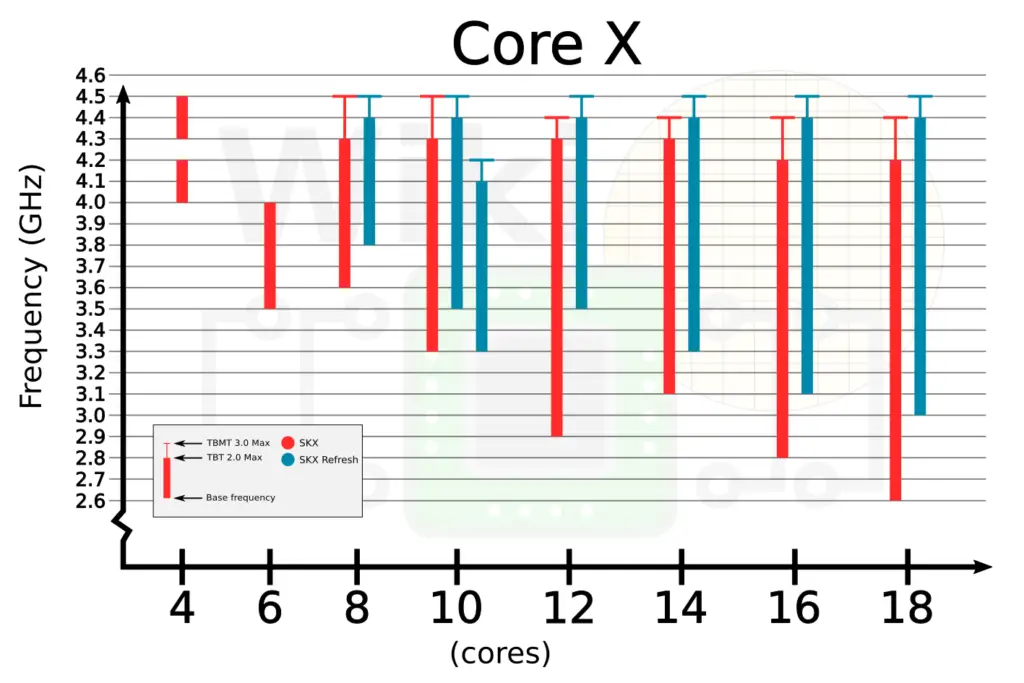
All Core X processors are unlocked and support up to quad-channel DDR4-2666 memory. They all have Turbo Boost Max Technology 3.0 which is applied to the two best cores. Additionally, they all have AVX-512 support with two FMA units enabled for double the throughput. Note that the full turbo frequencies for the new Core X parts were not given. An Intel spokesperson told WikiChip, “we [Intel] don’t spec per-core or all-core turbo frequencies for our processors.” They did say the all-core turbo frequency is verified. One number was confirmed: the 18-core i9-9980XE all-core turbo frequency is verified for 3.8 GHz.
Hardware Security
The refreshed models are not a new design and therefore do not have any of the hardware mitigations.
| Skylake X Refresh Spectre and Meltdown Protections | ||
|---|---|---|
| Variant | Name | Protection |
| Variant 2 | Branch Target Injection | Microcode + Software |
| Variant 3 | Rogue Data Cache Load | Microcode |
| Variant 3a | Rogue System Register Read | Microcode |
| Variant 4 | Speculative Store Bypass | Microcode + Software |
| L1TF | L1 Terminal Fault | Microcode + Software |
28-Core Xeon W-3175X
Back in June at Computex Intel teased a 5 GHz overclocked 28-core processor. One of the announcements Intel made on Monday is a new 28-core unlocked Xeon workstation processor.
| New Xeon W Processors | |||||
|---|---|---|---|---|---|
| Model | C/T | Base | Turbo | TDP | L3$ |
| W-3175X | 28 / 56 | 3.1 GHz | 4.3 GHz | 255 W | 38.5 MiB |
Pricing and launch date were not announced but Intel stated those parts will start shipping in December. We have confirmed that this processor will use Socket-P (LGA-3647) and use the Lewisburg chipsets (C621). This model comes with a base frequency of 3.1 GHz and a single-core turbo frequency of 4.3 GHz but has an unlocked multiplier so presumably, with a very good cooling solution, this processor should clock further. It’s worth noting that at 3.1 GHz, this processor has a much higher base frequency than even the Xeon Platinum parts, albeit at a higher TDP. The chip is positioned as Intel’s absolute best workstation part for heavily threaded workloads. It has support for up to 512 GiB of hexa-channel DDR4-2666 memory and ECC support and as with the rest of the Xeon W family, there are x48 PCIe lanes.
Hardware Security
The Xeon W-3175X does not have any of the hardware mitigations.
| Xeon W-3175X Spectre and Meltdown Protections | ||
|---|---|---|
| Variant | Name | Protection |
| Variant 2 | Branch Target Injection | Microcode + Software |
| Variant 3 | Rogue Data Cache Load | Microcode |
| Variant 3a | Rogue System Register Read | Microcode |
| Variant 4 | Speculative Store Bypass | Microcode + Software |
| L1TF | L1 Terminal Fault | Microcode + Software |
STIM
One of the major improvements introduced with the new processors is the re-introduction of a solder-based thermal interface material (STIM) between the integrated heat spreader (IHS) and the processor die.
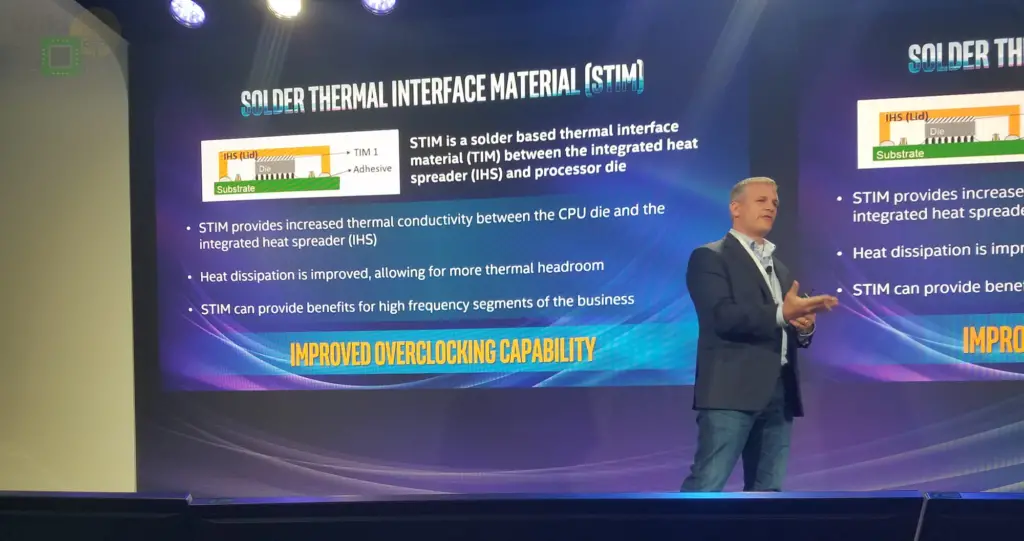
Spreading the heat generated by the integrated circuit is done using a copper heat spreader (nickel plated). A thermal interface material (TIM) physically connects the die to the copper heat spread. The TIM has two different roles: dissipate heat (performance, yields higher frequency) and absorb strain (reliability, relieving thermally-induced stress due to CTE mismatch). Intel’s current TIM works fine for most users. For those who push their processors to their limit with very higher operating temperatures, however, a material with higher bulk thermal conductivity is highly desired.
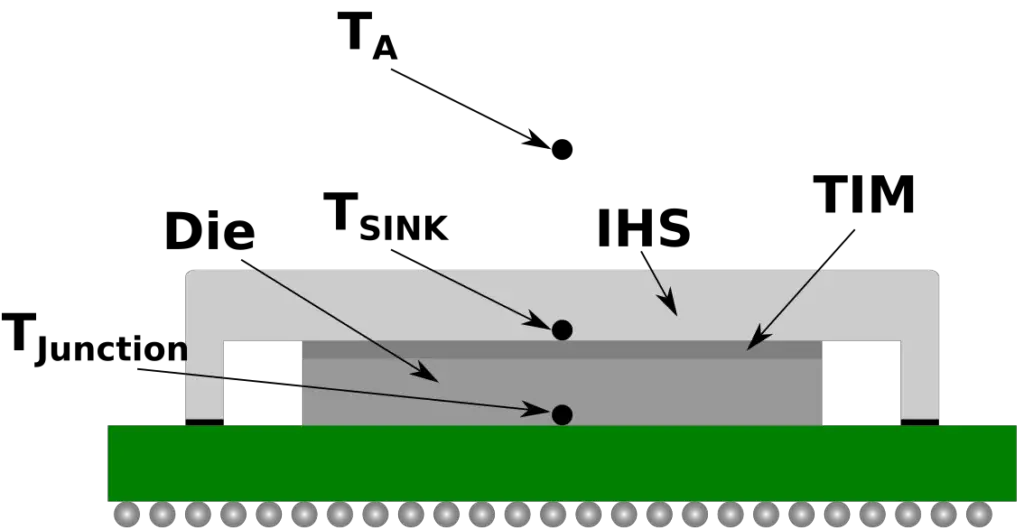
This is where using a solder-based TIM helps. STIM increases the thermal conductivity between the die and the integrated heat spreader thereby improving the available thermal headroom which should allow for higher sustained frequencies under a sufficient cooling solution – at least in theory.
STIM is used for the following products:
| STIM | ||
|---|---|---|
| Product | STIM Used? | |
| 9th Gen Core Processors | Yes | |
| Core X Series | Yes | |
| Xeon W-3175X | No | |
Note that the above table only applies to the processors that were announced on Monday (listed in this article).
–
Spotted an error? Help us fix it! Simply select the problematic text and press Ctrl+Enter to notify us.
–

